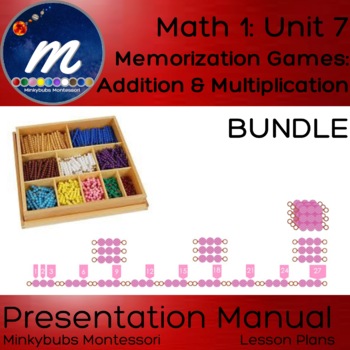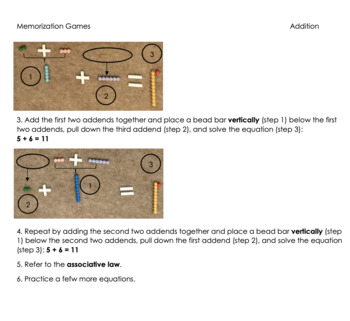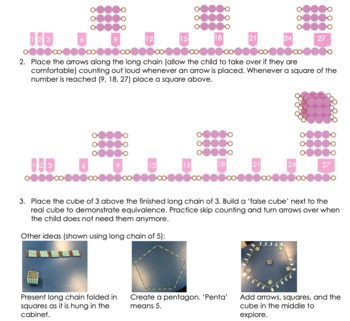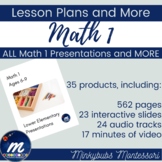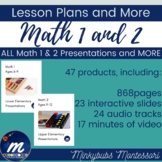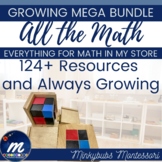Montessori Math 1 Manual Snake Game Add Multiply Lesson Plans Bundle Unit 7
- Zip
Products in this Bundle (2)
Also included in
- Lower Elementary Montessori Math 1 Comprehensive Teaching Manual and the Story of Math Great Lesson Story: 3+ years of Math CurriculumSee the preview file for a detailed list of presentations.The only complete and comprehensive Lower Elementary Montessori Math Manual you will ever need. This is forPrice $100.00Original Price $130.25Save $30.25
- Lower Elementary Montessori Math 1 Comprehensive Teaching Manual, Printable Resources, eLearning Resources, Command Cards, Stories including the Story of Math Great Lesson Story: 4+ years of Math Curriculum includes KindergartenAny time I add a Kindergarten to Grade 3 (Lower Elementary) Math resourcPrice $250.00Original Price $339.75Save $89.75
- ALL Lower and Upper Elementary Montessori Math 1 and 2 Comprehensive Teaching Manual and the Story of Math Great Lesson Story: 6+ years of Math CurriculumThe only complete and comprehensive Elementary Montessori Math Manual you will ever need. This is for children aged 6-12 years.This manual was crePrice $145.00Original Price $193.25Save $48.25
- This is a massive math bundle - it includes:Math Manuals and Lesson Plans for Ages 5-12 (hundreds and hundreds of pages)Hundreds of pages of printable task cards and supplementary resourcesHundreds of pages of printable materials for useDigital Learning Resources (including BOOM decks)eLearning moduPrice $389.48Original Price $432.75Save $43.27
Description
Snake Game Addition, Multiplication, and a whole bunch of math memorization games!
Learn the original Montessori memorization games for little addition and multiplication here from an accredited Montessori source.
These 18 games prepare the child's mind indirectly for the concept of algebra.
For some reason the video is displaying two of the cover pages incorrectly, the formatting on the actual cover pages is good!
Addition Games
Game 1: Snake Game Addition
Direct Aim:
To aid the child in memorizing all the addition combinations.
To familiarize the child with all the possible number combinations that make ten.
To memorize addition facts.
Indirect Aim:
To prepare the mathematical mind.
To prepare for counting in base ten.
To develop order, concentration, coordination, and independence.
Game 2: Static Addition
Direct Aim:
To show that an addition can be made with bead quantities.
Indirect Aim:
To develop independence and sharpen the mathematical mind.
Game 3: Dynamic Addition
Direct Aim:
To show that an addition can be made with bead quantities.
Indirect Aim:
To develop independence and sharpen the mathematical mind.
Game 4: Commutative Property of Addition
Direct Aim:
To show the commutative law.
Indirect Aim:
To develop independence and sharpen the mathematical mind.
Game 5: Associative Property of Addition
Direct Aim:
To introduce the associative law.
To introduce mental division, where the child must keep a sub-total of one combination in mind and then add it to another addend. At this point we are moving beyond chart 1.
Indirect Aim:
To develop independence and sharpen the mathematical mind.
Game 6: Using Parentheses in Addition
Direct Aim:
To introduce work with parentheses.
Indirect Aim:
To develop independence and sharpen the mathematical mind.
Game 7: Dis-associative Property of Addition
Direct Aim:
To give the dis-associative law.
Indirect Aim:
To develop independence and sharpen the mathematical mind.
Game 8A/8B: Addends Greater than 10 (Static and Dynamic)
Direct Aim:
To help the child to abstractly perform dynamic addition mentally.
Indirect Aim:
To develop independence and sharpen the mathematical mind.
Multiplication Games
Game 1: Snake Game Multiplication
Direct Aim:
To show unit combinations of multiplication with bead quantities.
To memorize Multiplication facts.
Indirect Aim:
To prepare the mathematical mind.
To develop order, concentration, coordination, and independence.
Game 2A/2B: Skip Counting - Short Chains (A)/Long Chains (B)
Direct Aim:
To give the names of the square and cube.
To show the linear passage from line to square and square to cube (using the chains).
Indirect Aim:
To develop independence and sharpen the mathematical mind.
To prepare for work with the powers.
To provide a geometric vision of the perimeters of regular polygons.
To prepare for the understanding of multiples and divisibility.
To show the child the difference between different bars, squares, and cubes.
Game 3: Forming a Whole Multiplication Table
Direct Aim:
To show the meaning of multiplicand and multiplier (the multiplier will be the number of bead bars laid out).
Indirect Aim:
To prepare for the concept of surface (1 bar is a line, multiple bars are a surface) To prepare for work in geometry (different rectangles, lines, and squares). To develop independence and sharpen the mathematical mind.
Game 4: Multiplication by 10
Direct Aim:
To discover what happens to a number when it is multiplied by 10. To understand we can just add a zero when we multiply by 10.
Indirect Aim:
To develop independence and sharpen the mathematical mind.
To prepare for the study of area.
To prepare for factoring work.
To prepare for the study of multiples and divisibility.
To prepare for division memorization.
To prepare for the study of prime numbers.
Game 5: Ways to Form a Product
Direct Aim:
To attempt all possible ways to make a product.
Indirect Aim:
To prepare for factoring work.
To prepare for the study of multiples and divisibility.
To prepare for division memorization.
To prepare for the study of prime numbers.
Game 6: Little Multiplication
Direct Aim:
To further abstract multiplication (the product is not shown in the bead representation).
Indirect Aim:
To develop independence and sharpen the mathematical mind.
Game 7: Inverse Products (Commutative Property)
Direct Aim:
To emphasize the value of two factors of multiplication.
To use the visual, auditory, and stereognostic sense to memorize multiplication combinations.
Indirect Aim:
Preparation for future work on building the squares of numbers.
Game 8: The Squares from 1 to 10
Direct Aim:
TO understand the power of an exponent.
Indirect Aim:
Preparation for future work on building the squares of numbers.
This work can be completed without the use of the bead bars during the lesson, but it is more effective for the child if they can experience the lesson sensorially.
The colours used in the images follow Montessori's bead bar colours.

